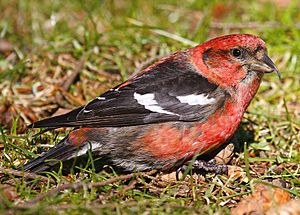Two-barred crossbill facts for kids
Quick facts for kids Two-barred crossbill |
|
|---|---|
 |
|
 |
|
| Male above, female below | |
| Conservation status | |
| Scientific classification | |
| Genus: |
Loxia
|
| Species: |
leucoptera
|
 |
|
| Distribution Year-round Nonbreeding |
|
The two-barred crossbill or white-winged crossbill (Loxia leucoptera) is a small passerine bird. It belongs to the finch family, called Fringillidae. These birds live in the conifer forests of North America and a large area of Europe and Asia called the Palearctic. They are known for their unique bills that cross at the tip.
Contents
About the Two-barred Crossbill's Name
Scientists give every animal a special two-part name. This helps everyone around the world know exactly which animal they are talking about. The two-barred crossbill's scientific name is Loxia leucoptera.
The bird was first officially described in 1789 by a German scientist named Johann Friedrich Gmelin. He gave it the name Loxia leucoptera. The word leucoptera comes from ancient Greek. It means "white-winged," which is a great description for this bird!
There are two main types, or subspecies, of the two-barred crossbill:
- L. l. bifasciata: This type lives in northern Europe, across Siberia, and into northeast China.
- L. l. leucoptera: This type lives in Alaska, Canada, and the northern parts of the USA.
What Does a Two-barred Crossbill Look Like?
This bird is about 14.5 to 17 centimeters (about 6-7 inches) long. It weighs between 25 and 40 grams, which is about the same as 5 to 8 quarters. It has short legs and a tail that looks forked, like a V-shape.
The most special thing about this bird is its bill. The top and bottom parts of its beak cross over each other! It also has two clear white stripes on its wings. These stripes give the bird its name.
- Males: Adult male crossbills are a bright raspberry-red color on their heads and backs.
- Females: Females do not have the red color. Instead, they are greenish-yellow on their heads and upper bodies.
It is usually easy to tell the two-barred crossbill apart from other crossbills. This is especially true in North America. The white wing-bars are the best way to identify them. Some other crossbills might have faint white marks, so it is important to look closely. The sound they make, a "chip" call, is also softer and higher than other crossbills.
Where Do Two-barred Crossbills Live?
These birds live in conifer forests. These are forests with trees like pines, spruces, and larches. You can find them in cold northern places like Alaska, Canada, and the northern USA. They also live across northern Europe and Asia.
Two-barred crossbills usually stay in the same area all year. But sometimes, if there is not enough food, they will fly south. This is called an "irruption." The birds from North America seem to travel more often than those from Europe and Asia. Outside of breeding season, these birds often fly in groups. Sometimes, they even join groups of other types of crossbills.
How Two-barred Crossbills Find Food
Two-barred crossbills are very good at eating seeds from conifer cones. Their unusual crossed bill is perfect for this job! They use their bill to pry open the scales of the cones. Then, they can easily pull out the seeds inside.
They especially love to eat seeds from larch trees. In Europe and Asia, they eat Siberian larch and Dahurian larch. In North America, they prefer Tamarack larch. They also eat berries from rowan trees. Sometimes, in North America, they will eat seeds from eastern hemlock and white spruce cones.
Reproduction and Life Cycle
Two-barred crossbills build their nests high up in conifer trees. The nest is usually placed close to the tree trunk. It can be anywhere from 2 to 20 meters (about 6 to 65 feet) above the ground.
The female bird builds the nest. She mostly uses small conifer twigs. She lays 3 to 4 eggs. The female then sits on the eggs to keep them warm for about 14 to 15 days. This is called incubation. Both parents help feed the baby birds, called chicks. The chicks leave the nest after about 22 to 24 days. But they stay with their parents for up to 6 more weeks while they learn to find food on their own.



